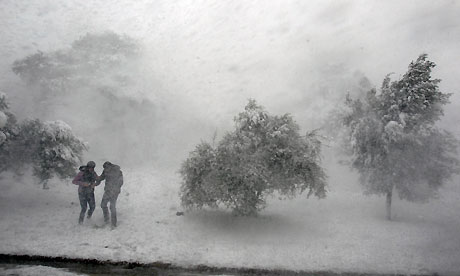Clay Johnson has an interesting idea, and I encountered his talk at this month's Tools of Change for Publishing Conference. I can even explain it for you, but of course Johnson does it much more entertainingly, and the TOC talk is on the web. In short, Johnson's thesis is that the things that are right and wrong with out information diets are the same things that are right and wrong with our food diets.
Humans are evolved to prefer fat and sugar over the things that are good for us because these foods were scarce in the environment we evolved in. Fat and sugar aren't scarce anymore, and the result is that we eat too much of them and are not as healthy as we could be. Worse, the economic structure of our society has created incentives for corporations to create huge complex systems that efficiently feed us sweet fatty food at a low cost. It's what we want. Fast Food.
Thus the "slow food movement". Slow food is the opposite of fast food. Inefficiently and locally produced with few of the benefits of technology or high fructose corn syrup from Iowa. Cooked from raw ingredients, crafted by a grandmother in a small kitchen. High in fiber, vitamins, protein and minerals. Low in antibiotics and fossil fuel byproducts. I exaggerate, but I'm smelling a frozen pie in the oven, and my zeal for slowness is tempered by my desire... to finish writing before it cools!
We suffer similarly from our "information diets". People want information that confirms what they already believe. Who wants to be intellectually challenged, really? We want sweet stories that entertain us, make our lives seem justified, and feed the emotions we most want to feel. And so we get information products designed to give us what we want, not what's good for us. Our news is designed and selected for search engine optimization rather than human wisdom maximization. It's Fox News and MSNBC, not Walter Cronkite and the New York Times.
Johnson's idea and his presentation of it are so tasty, so delectable, so comforting, that once you absorb it you become suspicious that it's self-referential. Are we liking the idea because it's confirming a bias we already have? Is it a "Fast Idea"? Aaaaack!
Luckily there's a book, The Information Diet, published by O'Reilly. The book's cover looks like a cereal box, the kind that's supposed to be good for you. The book is thin and lean, and has little of the fat or sugar of Johnson's presentation. It has footnotes and ScienceDirect URLs in all their unshortened bleakness. There are no pictures. It's the ideal souvenir from a Clay Johnson talk. It grounds Johnsons talk in tight argument and factual background. It's a "Slow Book" for a "Fast Idea".
And this leads Johnson to a concept that he calls "Infoveganism" in the book, but more appealingly, "Slow Information" in his talk.
A healthy Information diet always starts locally-and your political information should be no different. The goings-on of your state representatives and city and county governments, along with your school boards, and other local government offices are the best, healthiest forms of content for political news, and should be consumed over the national or global news.Really. The main problem I have with Johnson's book is its "veganism". It's a sermon that, as much as I might agree with it, is not going to change my behavior.
It's my view that economic and social incentives are what ultimately determine the behavior of organisms, not information, whether slow or fast. If we want a better information diet, we need to alter the economics of information availability. That's why a society with libraries can be better that a society with only bookstores, Harry Potter notwithstanding. It's also why I'm developing Unglue.it. If authors and publishers are rewarded for the value that people have received from books rather than for the catchiness of the cover art or the placement in the bookstore, we'll have better books to read. The books will last longer, and they'll connect people in richer ways. They'll be "slow books" because the economic model will have a long view.
I think I'll skip the whipped cream on my apple pie!
Article any source


















